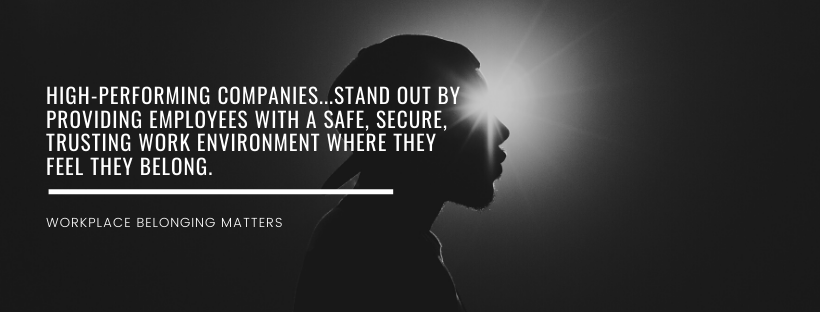Providing employees with a sense of connection, support, and belonging is now more important than ever. When employees feel valued and supported in the workplace, they are more productive, more creative, and develop a deep commitment to their jobs [1]. All of this tracks on to gaining a ‘competitive advantage’ and leading metrics for business success [2]. It’s also true that lacking a sense of belonging has been identified as the top reason for voluntary staff turnover, especially among historically underrepresented groups [3]. Indeed, workplace belonging is vital to achieving your bottom line in business.
What’s Workplace Belonging?
To fully understand why workplace belonging is crucial for a company’s bottom line, one must first grasp the intended meaning of the term. Sense of belonging is the feeling of security and support that results when there is a sense of acceptance, inclusion, and identification for members of a certain group. Although it’s a basic human need—a fundamental drive—to form and maintain lasting, positive relationships with others [4], the need to belong can assume special importance in interdependent social settings like work—where the average person spends 8 to 12 hours per day with others, Monday through Friday, including weekends and summers in most cases.
Workplace belonging, it follows, refers to feelings of being accepted, cared about, included, thought of, and valued by those around you at work. And while 40% of people say that they feel isolated at work regardless of identity [5], Gallup data show a concrete link between ‘having a friend at work’ and improved business outcomes like effort expended on the job.
Sense of belonging is the feeling of security and support that results when there is a sense of acceptance, inclusion, and identification for members of a certain group.
Terrell Strayhorn (2019), College Students’ Sense of Belonging (Routledge)
Why Workplace Belonging Matters
When workers feel like they belong, companies—from corporations to campuses—reap major benefits and bottom-line gains. Companies realize substantial savings as sick days decrease and staff turnover stabilizes. Workplace belonging is correlated with other factors like employee engagement, defined as the level of connection, motivation, and commitment a person feels for the place they work [6]. Academic studies have shown that workplace belonging is positively associated with other metrics of organizational effectiveness, ranging from employee wellness, happiness, and morale to staff retention, as a few examples [7]. Results converge on several consistent findings. According to BetterUp’s recent study, employees who feel a strong sense of belonging:
- Report a 50% reduction in turnover risk;
- Show a 56% increase in performance;
- Demonstrate a 75% decrease in sick days;
- They’re 167% more likely to recommend their employer as a ‘great place to work.’
High-performing companies outpace their competition in more than cost containment, monthly recurring revenue, and churn rate; they stand out by providing employees with a safe, secure, trusting work environment where they feel they belong. Unlike profit margins and process times, sense of belonging is not easily observable to the naked eye. It’s a feeling, a sensation, that evolves over time in response to policy, program, and practice interventions.

What Leaders Can Do To Foster Workplace Belonging
Creating an environment of belonging at work is a best management practice. Of course, leaders can’t make employees feel a sense of belonging per se. Belonging is about feelings, not instructions. It can’t be commanded, it must be cultivated cooperatively. It’s the job of leaders and managers to create an environment in which cooperative cultivation can flourish and thrive. For instance, adopting workplace discrimination and harassment policies that prohibit exclusion and physical/psychological harm helps ensure the safety of all staff.
Leaders who want to drive top performance within the workforce make belonging a key priority. They prioritize belonging publicly by including it as a strategic goal in short- and long-term plans. They incorporate it in vision statements, annual reports, and even company taglines. But they also put ‘words to action’ by modeling inclusive leadership, from the top-down. They ask staff how they’re doing today and wait to listen attentively to the answer; they ask follow-up questions, acknowledge feelings, and avoid distractions (e.g., smartphones) when engaging team members.
For people to find meaning in their work, employees need frequent validation and recognition that what they do matters. Team leaders and front-line managers should provide immediate feedback to staff whenever possible. Interim evaluations, informal reviews, and oral comments can be used to give relevant, timely information to staff about their performance and areas where there’s room for improvement. Senior leaders and HR managers might establish values-based social recognition (or rewards) programs that celebrate the contributions and achievements of individuals and groups to the larger whole. Crowdsourced recognition and monetary bonuses seem to be most valued by workers—crowdsourced praise can be as simple as “Please join me in celebrating Tyrone Doe for going above and beyond yesterday in…. Tyrone can be reached at [email] or [phone].”
Sense of belonging is about inclusive excellence, not just having a seat at the table. It’s about being part of the conversation, invited to share one’s experience, and feeling valued as a co-creator of a welcoming work culture where people can ‘show up’ authentically. CEOs, leaders, and managers can play a major role by inviting representatives from all ranks and units to serve on employee experience committees. Empowering such committees to lead charge is also important. Resource them to be able to generate and implement big ideas to boost belonging for the team, in consultation with human resources. Proven strategies for building high-touch work environments include cross-team competitions, formal mentoring activities, community service, and 1-on-1 time with supervisors.
In closing, belonging isn’t only good for business. It’s good for you, your employees, your consumer, and bottom line. After all, we all want to belong [8].
REFERENCES
[1] Carr, E., Cooney, G., Gray, C., Greenberg, S., Kellerman, G., Reece, A., & Robichaux, A. (2019). The value of belonging at work: New frontiers for inclusion. San Francisco, CA: BetterUp.
[2] Kumar, V. & Pansari, A. (2016). Competitive advantage through engagement. Journal of Marketing Research, 53(4), 497-514.
[3] Scott, A., Klein, F. K., & Onovakpuri, U. (2017). Tech leavers study. Kapor Center.
[4] Maslow, A. H. (1943). A theory of human motivation. Psychological Review, 50(4), 370-396.
[5] Twaronite, K. (2019). The surprising power of simply asking coworkers how they’re doing. Harvard Business Review. Retrieved May 4, 2020 from http://hbr.org/2019/02/the-surprising-power-of-simply-asking-coworkers-how-theyre-doing
[6] Bersin, J. (2015). Becoming irresistible: A new model for employee engagement. Deloitte Review, 16, 146-163.
[7] Shakespeare-Finch, J., & Daley, E. (2017). Workplace belongingness, distress and resilience in emergency service workers. Psychological Trauma: Theory, Research, and Policy, 9(1), 32-35.


